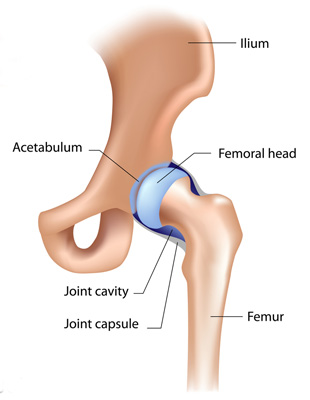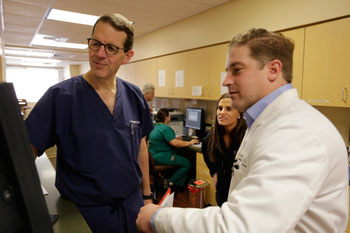Arthritis

The primary cause of hip pain is arthritis, specifically osteoarthritis. Arthritis is the most common chronic condition and is characterized by inflammation of the joints. Common causes of arthritis include wear and tear on the bones and joint cartilage, most often when the body has too much weight to support. This can be caused by carrying heavy loads consistently for years but is more commonly a byproduct of being overweight.
Common Arthritis Myths
- Only older people have arthritis.
- Arthritis is caused by cold, wet weather.
- Each day is the same for an arthritis patient.
- Arthritis is a minor physical inconvenience.
Osteoarthritis
Osteoarthritis is the most common form of arthritis, affecting over 21 million Americans. Three times as many women suffer from the disease than men.
Osteoarthritis occurs when the covering on the ends of bones gradually wears away, becoming frayed and rough. It typically develops due to many years of use and affects people middle-aged and older. Osteoarthritis targets hands and weight-bearing joints, such as knees, hips, and feet.
Risk Factors
- Age- 45 yrs or older
- Gender- majority of sufferers are women
- Certain hereditary conditions including defective cartilage and malformed joints
- Joint injuries caused by physical labor or sports
- Obesity
- Diseases that alter normal structure and function of cartilage
Symptoms (usually come on slowly)
- Pain and inflammation
- Pain may develop gradually and feel like a deep ache.
- Swelling and stiffness
- May be worse in the morning and feel better with activity
- Loss of range of motion
- “Sticking” and weakness
- Loose fragments of cartilage and other tissue can cause locking or “sticking."
- Joint may lose strength and buckle or lock.
Avascular necrosis

Avascular necrosis occurs when the tissue in the joints literally die when the blood supply is cut off to the bones. This can be a temporary blood supply loss or a permanent loss. Causes of avascular necrosis can include alcoholism, steroids, or blood disorders.
In the early stages of avascular necrosis, pain only occurs when pressure is put on the joint. However, as the necrosis worsens the pain is present even while resting the joint. In many cases, the blood supply is lost permanently and the damage tissue must be removed and replaced with a hip replacement.
Mechanical abnormalities
Mechanical abnormalities are rare, but can stem from childhood disfigurement or fractures that never healed properly. Initially, the body will try to compensate for the abnormality. However, as time passes, this will create wear and tear on other parts of the body. Ultimately, the remedy for this can be hip replacement.
Osteoporosis
Those with fragile bones that may easily break have osteoporosis. The disease is the result of lower than average amounts of phosphate and calcium in the bones, which cases them to become porous and brittle. Bones that most commonly break are the bones in the wrist and hip.

There are both controllable and uncontrollable risk factors that increase or decrease odds of developing the disease. For instance, people of all ages, races and genders get osteoporosis, but it is a condition most commonly found in Caucasian and Asian females over the age of 60. Other uncontrollable risk factors include family history, certain diseases and hormone levels. Controllable factors encompass those things that an individual can do during their lifetimes to lower their risk for developing osteoporosis. For instance, smoking, excessive drinking (more than 7 ounces of alcohol per week), poor nutrition with low calcium intake and lack of exercise can all contribute to the development of the disease.
The best treatment for the disease is prevention by consuming the recommended amounts of calcium and phosphate throughout a lifetime. When the disease is recognized, calcium is prescribed into the diet immediately, hormone treatments may help and an exercise regimen is recommended to abate further deterioration of the bone. To find out if you have osteoporosis, an energy X-ray absorptiometry (DEXA) scanning can analyze bone density.
Overweight
Our hips form and develop in mass and strength in proportion to the amount of weight our body was designed to hold. So if you are a small woman, your hips are meant to hold a smaller amount of weight than if you are a six-foot tall man. Although the body is very adaptable and can learn to hold different weights, a point can be reached where the body is simply not comfortable supporting excess weight.
In some cases, along with surgery, a lifestyle change needs to take place to keep chronic pain at bay. For instance, diet should be addressed immediately, and an exercise regime should ensue following recovery from surgery.
